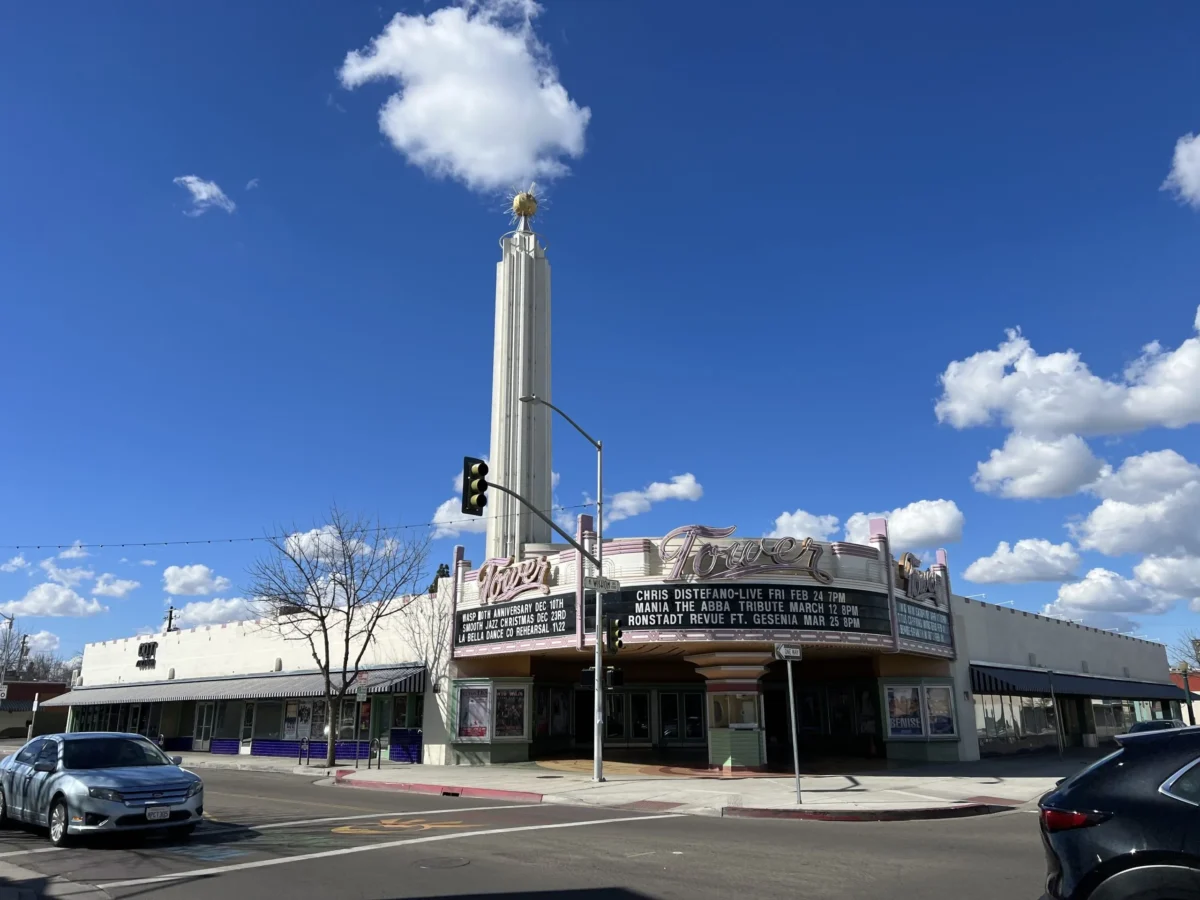
Residents have recently formed the South Tower Land Trust to help keep the neighborhood affordable amidst rising rents and home prices. Credit: Heather Halsey Martinez / Fresnoland
Written by Megan Tagami with Fresnoland
This story was originally published by Fresnoland, a nonprofit news organization.
In April of 2021, Bri and Dylan Villanueva Hardcastle received notice that the rent for their Tower District apartment would be raised from $900 to $1,250 a month.
Over the next three weeks, the Villanueva Hardcastle family scoped out one or two bedroom apartments within the price range they could afford, but all they saw had monthly rents ranging from $1,250 to $2,500 – all out of the couple’s budget. Almost out of time and options, they began to consider moving in with family members; then, they drove past a duplex with a “For Rent” sign in front of it.
Bri Villanueva Hardcastle and her husband have lived in the duplex for almost two years now, but their housing situation is still imperfect, she said. The ceiling leaks and the windows don’t seal all the way, but she remains determined to remain in the neighborhood where she grew up. She added that housing costs in her hometown have recently risen to prices beyond what is affordable for a young working couple.
“If I hadn’t gotten lucky, I don’t know where I’d be living right now,” Villanueva Hardcastle said.
Between 2015 and 2022, housing prices in Fresno increased approximately 70% while rental prices went up 80%, according to Hongwei Dong, an associate professor in the department of geography and city and regional planning at Fresno State. Dong attributed the city’s rising housing costs to the influx of remote workers who arrived during the COVID-19 pandemic in search of cheaper homes and good local schools.
Fresno’s elected leaders have also taken steps to address housing affordability concerns. In 2022, Mayor Jerry Dyer launched the One Fresno Housing Strategy. The report outlined 47 policy proposals that would cost the city over $100 million and address the need for 15,000 affordable housing units.
Advocates say community land trusts can be a solution to the challenges Villanueva Hardcastle and many other residents face. City leaders and housing experts are cautiously optimistic that land trusts can help to address Fresno’s escalating housing crisis. In 2022, the Mayor’s One Fresno Strategy included a recommendation that the city invest $1 million into a local community land trust that could produce up to 25 units of affordable housing.
What is a community land trust?
According to Leo Goldberg, co-director of policy and capacity building at the California Community Land Trust Network, a land trust is typically a nonprofit organization, which purchases land and builds affordable housing units which are available for rent or purchase by low-income residents. Proponents claim that this approach keeps the housing permanently affordable.
The trust always maintains ownership of the land on which the homes are built and can thus ensure that housing units are continually sold or rented at below-market rates. At the same time, residents and community members have a say in the land trust’s governance, thus ensuring that the land use is aligned with local priorities, Goldberg added.
California’s first community land trust began in Berkeley in the late 1970s. Since then, about 22 trusts are active in the state; most have emerged over the past 10 years.
“There’s just a huge amount of growth,” Goldberg said. “Many of the community land trusts are in the early phases, they own just one or a handful of properties, but are looking for opportunities to grow.”
In southern California, the Irvine Community Land Trust has developed four apartment buildings and one townhome community since its establishment in 2006, said executive director Mark Asturias. He added that the land trust’s projects have created over 400 affordable housing units, some of which are designated for homeless families, veterans and other high-need populations. These homes have also garnered thousands of applicants.
“We are in the business of building housing that is affordable, and we can make it so that employees in the workforce can actually live near where they work,” Asturias said. “We are extremely needed.”
Central California Land Trust
In Fresno, the inspiration for the first community land trust came in 2015, when Matthew Grundy, the former CEO of Habitat for Humanity Greater Fresno Area, realized that the affordability covenants of local homes were expiring. Grundy said that as homes entered the market and sold for higher prices, he began exploring new ways to keep housing permanently affordable in the city. In his search, he uncovered the community land trust model.
“Affordability for good is something worth considering,” said Grundy, who currently serves as the deputy mayor of Fresno.
In 2017, Grundy helped form the Central California Land Trust, hoping at the time that the trust would partner with Habitat for Humanity to purchase and develop a property that would yield around 70 homes. However, Cary Catalano, the director of development for Habitat for Humanity Greater Fresno Area, said the project faced unexpected development challenges and was too expensive for the land trust. Catalano, who is the chairman of the county board of the Fresno Housing Authority, is also a founding member of the Central California Land Trust.
Patience Milrod, chairwoman of the Central California Land Trust, said the board has since considered alternatives, including salvaging and renovating abandoned properties that have been previously damaged by fires in the Fresno area.
“Those are structures that could have been saved, if there had been an entity to receive them, like a land trust,” Milrod said. “We can save those structures.”
She said that the land may be used not only for affordable housing, but also for commercial spaces available to low-income business owners and community parks and gardens. However, the land trust’s options depend on the outcomes of an ongoing feasibility study.
In November, the Central California Land Trust received $222,500 from the Fresno City Council to conduct its feasibility study. The council had rejected its original request of $1 million, stating the proposal lacked specific deliverables, according to Miguel Arias, the Fresno City Council representative for District 3.
Although the Mayor’s housing report recommended that the city allocate $1 million to community land trusts, Arias said this money is not guaranteed because he wants the Central California Land Trust to prove, through its feasibility study, that its work will add to the city’s affordable housing stock, rather than contributing to gentrification and displacement of current residents. He added that the trust should add more diversity to its board so that more people of color and low-income residents can have a say in future developments.
“We’re making an initial down payment as seed money and investment … so that, a year from now, when they’ve completed these initial critical tasks, they will be well positioned to receive additional city investment to the further development of the strategy,” Arias said.
Ashley Hedemann, the CEO for Habitat for Humanity Greater Fresno Area and a board member of the Central California Land Trust, said the land trust plans to incorporate community feedback throughout its development process to provide more opportunities for residents to become involved with the board after the completion of the strategic plan.
“We need to go in and understand what is it that we can truly do?” Hedemann said. “And at that point, we can have those really open, honest conversations with the community members.”
South Tower Community Land Trust
At the South Tower Community Land Trust, executive director Kiel Lopez-Schmidt shares Hedemann’s vision of engaging community members throughout the process of acquiring land and building new homes. But, like the Central California Land Trust, Lopez-Schmidt’s organization still has a way to go before it can begin producing homes.
Lopez-Schmidt has called the South Tower District home since age two. Lopez-Schmidt said the district was originally a bustling arts community, with locally-owned grocery stores and pharmacies, but that the area has changed over time – with poorer air quality, more Dollar stores and fewer affordable housing opportunities.
That decline, said Lopez-Schmidt, is why they turned to community land trusts. The South Tower Community Land Trust is still in the process of securing its 501(c)(3) status and has not yet purchased property, Lopez-Schmidt said. However, they hope to eventually turn acquired land into community gardens and affordable homes. They added that community members will play a central role in the decision-making process.
Villanueva Hardcastle said she is eager to see what the land trust produces after her personal struggles finding affordable housing in the Tower District. She added that she takes comfort in knowing that community members, like Lopez-Schmidt, would be overseeing the land.
“I think that’s great to have people that are actually in the community, thinking of those things and thinking of us and the renters,” she said.
The land trust plans to focus on areas of the South Tower District that have been subject to industrial zoning or redlining in the past, said Alex Desiga, secretary for the board of the South Tower Community Land Trust.
“These communities have been created this way, inequality by design,” Desiga said. “You start to see really clearly which communities have been looked over, disenfranchised, had little to no investments.”
Lopez-Schmidt added that the land trust’s goal for 2023 is to raise $200,000, while continuing to engage residents in conversations about the possibilities of the land trust.
“The condition that we have today doesn’t limit what’s possible,” they said.
The challenges of a trust
It remains unclear as to when residents can expect to see the products of Fresno’s land trusts – and how large an effect these trusts will have on the city’s housing stock.
Goldberg said one of the greatest challenges for land trusts is finding adequate sources of funding. While more banks are becoming familiar with the community land trust model, not all institutions are willing to provide loans to new organizations, he said.
The state has recently passed legislation that makes it easier for community land trusts to acquire land. For example, the 2021 Foreclosure Intervention Housing Preservation Program will allocate $500 million to nonprofits and land trusts in order to help organizations purchase land at risk of being foreclosed, Goldberg said.
Still, some land trusts in the state struggle with finding a viable funding model.
Josefina Aguilar, executive director of the South Bay Community Land Trust, said her land trust began with the help of grants from the city and county, totalling $500,000. Still, she added that the trust needs to seek out philanthropic donations and outside support in order to continue purchasing land, renovating properties and keeping homes affordable.
“Having half a million dollars to establish the organization and its capacity – that’s rare, that this opportunity exists,” Aguilar said.
At the same time, building affordable housing at scale is a difficult task, Asturias said. While the Irvine Community Land Trust aims to build 70 homes at a time, the process is time-consuming, he said, adding that the land trust just received approval to convert a four-acre property into an affordable rental housing project, but construction may not start for another year.
“It’s going to take anywhere from 24 to 36 months to finish,” Asturias said. “But that’s the way development works in California.”
The Mayor’s housing report expects that a local community land trust may produce between 10 and 25 homes with $1 million in funding. However, the projection falls significantly short of the city’s need for 15,000 affordable housing units.
Yet, people remain cautiously optimistic about the future of Fresno’s land trusts. By moving families into permanent housing and giving residents a greater say in neighborhood governance, land trusts can empower communities to push back against gentrification and rising housing rates, said Naomi Bick, an assistant professor of political science at Fresno State.
Arias added that, while he recognizes the efficacy of land trusts, they must work in tandem with other approaches that address the city’s affordable housing needs.
“For me, the land trust is one of many strategies that we have to pursue simultaneously to be able to achieve our affordable housing goals,” he said. “It’s not a silver bullet for the housing crisis we have. It’s one of many strategies.”








